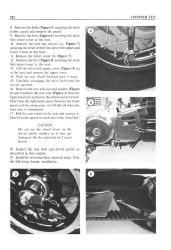Suzuki LS650 Savage 1986-2004 Service & Repair Manual
Catalog:
Model:
Complete workshop repair service manual with electrical wiring diagrams for Suzuki LS650 Savage 1986-2004. It's the same service manual used by dealers that guaranteed to be fully functional and intact without any missing page.
This Suzuki LS650 Savage Motorcycle service & repair manual (including maintenance, overhaul, disassembling & assembling, adjustment, tune-up, operation, inspecting, diagnostic & troubleshooting…) is divided into different sections. Each section covers a specific component or system with detailed illustrations. A table of contents is placed at the beginning of each section. Pages are easily found by category, and each page is expandable for great detail. The printer-ready PDF documents work like a charm on all kinds of devices.
“'86-'04 LS650 Savage.pdf”
Suzuki LS650 Savage 1986-2004 Service & Repair Manual; 368 pages
EXCERPT:
ENGINE
Valve Seat Reconditioning
Special valve cutter tools and considerable expertise are required to properly recondition the valve seats in the cylinder head. You can save
considerable money by removing the cylinder head and taking just the cylinder head to a dealer or machine shop and have the valve seats ground.
The following procedure is provided if you choose to perform this task yourself.
The Suzuki valve seat cutter and T-handle are available from a Suzuki dealer or from machine shop supply outlets. Follow the manufacturer's
instruction in regard to operating the curter. You will need the Suzuki Valve Scat Cutter (N-116), a T-handle and the Solid Pilot (N-100-6.98) or equivalent.
The valve seat for both the intake valves and exhaust valves are machined to the same angles.
The valve contact surface is cut to a 45° angle and the area above the contact surface (closest to the combustion chamber) is cut to a L5° angle (Figure 146).
1. Carefully rotate and insert the solid pilot into the valve guide. Make sure the pilot is correctly seated.
2. Use the 45° angle side of the cutter, install the cutter and the T-handle onto the solid pilot.
3. Using the 45° curter, descale and clean the valve seat with one or two turns.
CAUTION
Measure the valve seat contact area in the cylinder head after each cut to make sure the contact area is correct and to prevent removing too much material. If too much material is removed, the cylinder head must be ∂replaced.
4. If the seat is still pitted or burned, turn the 45° cutter additional turns until the surface is clean.
Refer to the previous CAUTION to avoid removing too much material from the cylinder head.
5. Remove the valve curter, T-handle and solid pilot from the cylinder head.
6. Inspect the valve seat-to-valve face impression as follows:
a. Spread a thin layer of Prussian Blue or machinist's dye evenly on the valve face.
b. Moisten the end of a suction cup valve tool (Figure 144) and attach it to the valve. Insert the valve into the guide.
c. Using the suction cup tool , tap the valve up and down in the cylinder head . Do not rotate the valve or a false indication will result.
d. Remove the valve and examine the impression left by the Prussian Blue or machinist's dye.
c. Measure the valve seat width as shown in.
Figure 145. Refer to Table 1 for the seat width.
7. If the contact area is too high on the valve, or if it is too wide. use the 15° side of the cutter and remove a port ion of the top area of the valve seat material to lower and narrow the contact area (Figure 147).
…





